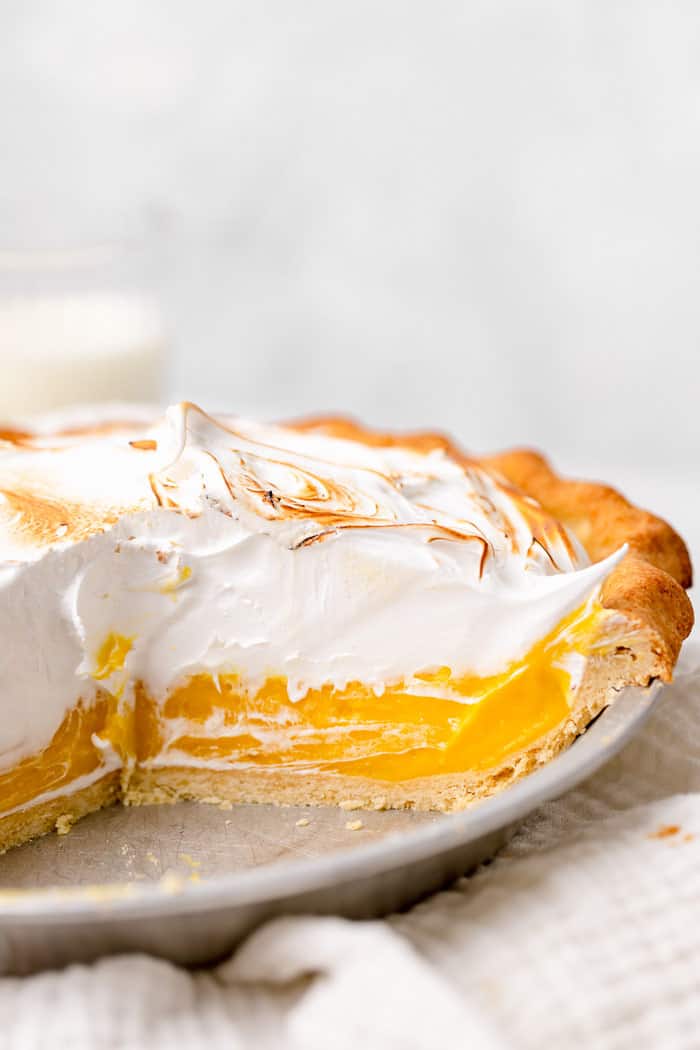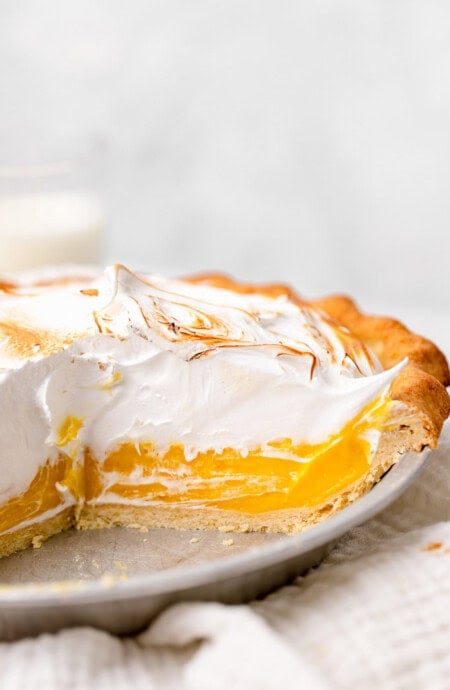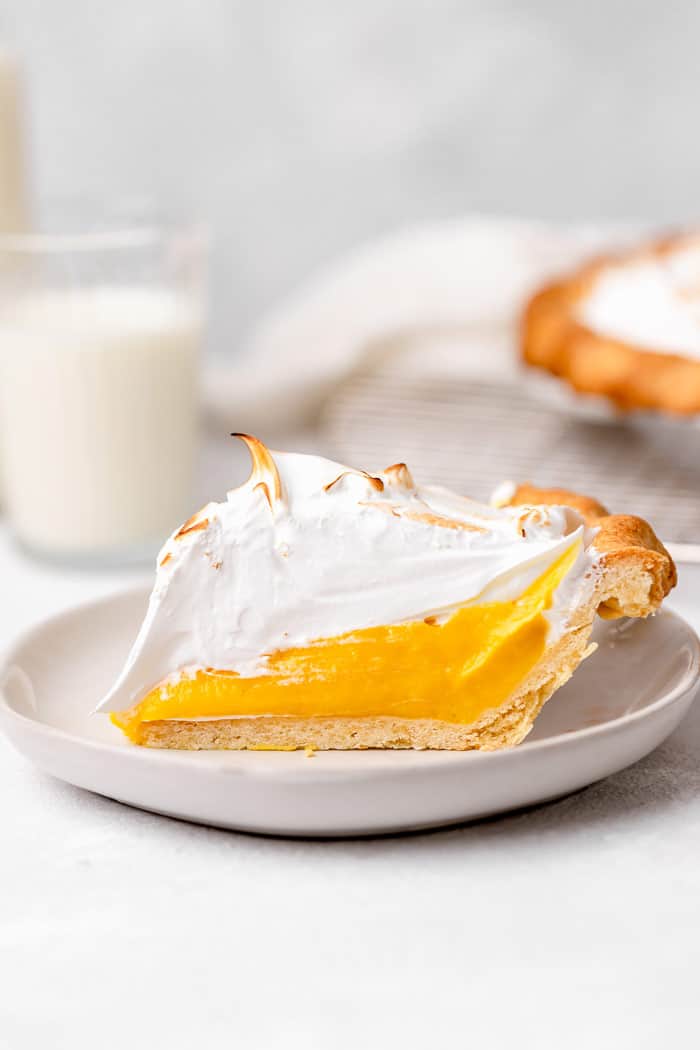Finding the best lemon meringue pie recipe is tough work but I’ve got you covered. This one has a flaky homemade pie crust, a tart lemon curd filling that’s super smooth and a mountain of sweet meringue piled on top. My boo Erin Jeanne McDowell definitely put her foot in this one. Give it a try and get at it.
This post may contain affiliate links. Read our disclosure policy.

How to Make Lemon Meringue Pie
For the Crust
- Whisk flour and salt, then massage butter into it until some crumbs develop and it looks kinda pebbly. Add ice water, mix until cohesive, then chill the dough disc.
- Dock and bake at 425 F until golden (25-29 mins total), then cool.
For the Filling
- Combine sugar, cornstarch, butter, lemon juice, egg yolks, and salt over medium-low heat. Stir until thickened and bubbly.
- Strain into crust, cover, and chill for 2 hours or up to a day.
Want to Save This Recipe, Boo?
For the Meringue
- Over simmering water, heat all ingredients to 160F, then whip to medium peaks.
- Mound onto pie and torch if desired for a toasty finish.

Lemon Meringue Pie Recipe
Made with the butteriest homemade pie crust, a creamy lemon filling and piled high with fluffy clouds of sweet meringue, this lemon meringue pie is a lemon lover’s dream come true!
Want to Save This Recipe, Boo?
Servings: 8 pie slices
Ingredients
For the Pie Crust
- 1 1/4 cup all purpose flour
- 1/4 tsp fine sea salt
- 8 tbsp cold unsalted butter cut into 1/2 inch cubes
- 1/4 cup ice water plus more if needed
For the Filling
- 1 cup granulated sugar
- 1/4 cup cornstarch
- 8 tbsp unsalted butter
- 1 1/4 cup fresh lemon juice from about 7 lemons
- 10 large egg yolks
- 1/2 tsp fine sea salt
- 1 9 inch pie crust blind-baked, brushed with egg wash, and cooled completely
For the Mile High Meringue
- 4 large egg whites
- 1/2 tsp cream of tartar
- 1 cup granulated sugar
- Large pinch of fine sea salt
- 2 tsp vanilla extract optional
Instructions
For the Crust
- In a large bowl, whisk together the flour and salt. Add the cubes of butter, tossing them through the flour until each piece is well coated. Cut the butter into the flour by pressing the pieces between your fingers, flattening them into big shards. As you work, continue to toss the butter through the flour, recoating the shingled pieces. If you have warm hands, you may want to use a pastry cutter. Take care to ensure that all the cubes of butter are fully coated in flour as you work.
- Make a well in the center of the flour mixture. Add the amount of ice water listed in the recipe to the well. Using your hands, toss the flour with the water to start to mix the two together. As the flour begins to hydrate, you can switch to more of a kneading motion but don't overdo it. Then add more water, about 1 tablespoon, until the dough is properly hydrated. It should be uniformly combined and hold together easily, but it shouldn't look totally smooth. Dough that is too dry may have a sort of "dusty" appearance, or pockets of unhydrated flour; it will not hold together and will look crumbly. Dough that is too welt will feel sticky or tacky to the touch.
- Form the dough into a disk and wrap tightly in plastic wrap. Refrigerate for at least 30 minutes before using. The dough is best baked at 425 F. Place your prepared (docked/weighted) crust in the oven and bake for 15 to 17 minutes, until the edges appear set and are just starting to lightly brown. Remove the crust from the oven and use the parchment paper to lift the pie weights out of the pan. Return th epie to the oven and bake until the crust is evenly golden brown and fully baked, 10 to 12 minutes more. Let the crust cool completely before filling it.
For the Filling
- In a small bowl whisk together sugar and cornstarch. In a medium pot, melt the butter over medium heat. Reduce the heat to medium-low, add the sugar mixture along with the lemon juice, eggs yolks, and salt. Cook, whisking constantly until the mixture begins to thicken, about 2 to 3 minutes more.
- Continue to cook, stirring constantly with a spatula, scraping along the edges until the curd thickens and comes to a boil (look for fat bubbles in the center), 2 to 3 minutes more.
- Strain the curd into the cooled pie crust and spread into an even layer. Cover with plastic wrap placed directly against the surface of the filling and transfer to the refrigerator to chill for at least 2 hours (or up to 24 hours).
- Just before serving, add the meringue topping: Dollop the meringue onto the center of the chilled pie and use a small offset spatula to push the meringue out toward the edges, but leave a mound in the middle. If desired, use a kitchen torch to toast the meringue.
For the Meringue
- Bring a medium pot filled with about 2 inches of water to a simmer over medium-low heat. Set a medium bowl over the pot, add all the ingredients, and whisk to combine. Then heat, whisking constantly, or beating with a hand mixer, until the mixture reaches 160F on a thermometer.
- Remove the bowl from the heat and continue to whisk or transfer the heated mixture to the bowl of a stand mixer fitted with the whip attachment. Whip the mixture on medium-high speed until it reaches medium peaks, 2 to 3 minutes for the regular meringue, or 4 to 5 minutes for the mile high version.
- Pile the meringue on top of the cooled pie. Spread the meringue out to the edges, but keep it mounded a bit higher in the middle. If desired, toast the meringue with a kitchen torch.
Notes
The pie can be made, without the meringue topping, up to 24 hours ahead; add the meringue just before serving. Store leftovers in the refrigerator in an airtight container.
Storage
Cool properly to room temp then place in the fridge for 2 hours. For best results, I recommend refrigerating for 24 hours. Make sure that you don’t store the pie outside of the fridge for more than 2 hours at a time. You should return the remaining pieces to the fridge after serving it. Store the pie in the refrigerator for up to 3 days. TIP: Avoid placing the pie in the freezer at any point! Meringues are made of eggs and sugar, so they don’t freeze well. If you do put the meringue in the freezer, it can become flat or crunchy, ruining the texture of your pie.Nutrition
Calories: 573kcal | Carbohydrates: 72g | Protein: 8g | Fat: 29g | Saturated Fat: 17g | Cholesterol: 304mg | Sodium: 282mg | Potassium: 140mg | Fiber: 1g | Sugar: 51g | Vitamin A: 1024IU | Vitamin C: 15mg | Calcium: 41mg | Iron: 2mg
Tried this Recipe? Tag me Today!Mention @GrandbabyCakes or tag #grandbabycakes!
Recipe Tips
- Get the Curd Thick: Since the transformation from liquid to goop happens so quickly, it’s tempting to take the curd off the stove too soon. Let it thicken to the point where it is a smooth paste. When you add the lemon juice, it will loosen the curd, so you want it to be thick going in.
- Use the three-bowl method: To keep egg yolk from getting into those egg whites for meringue make sure you try this. Separate the egg over one bowl, then place the yolk in another bowl. Transfer the successfully separated egg whites to the third bowl one at a time.
- Don’t Overbeat Your Meringue: If you overbeat your meringue, you will not be able to make beautiful peaks and valleys with your spatula and it can deflate.
- Don’t Freeze: Don’t put your pie in the freezer boos. Meringues don’t freeze well. If you do put the meringue in the freezer, it can become flat or crunchy, ruining the texture.
- Make Ahead: The pie can be made, without the meringue topping, up to 24 hours ahead. Just add the meringue just before serving and leave the pie in the fridge.

Excellent recipe…just like my grandmothers.Here is a great tip on storage. Instead of toothpicks simply cut one end of a Q tip off and insert into any pie, cake, cupcakes and wrap with plastic wrap or foil. It won’t poke through so problem solved.
Thank you so much!